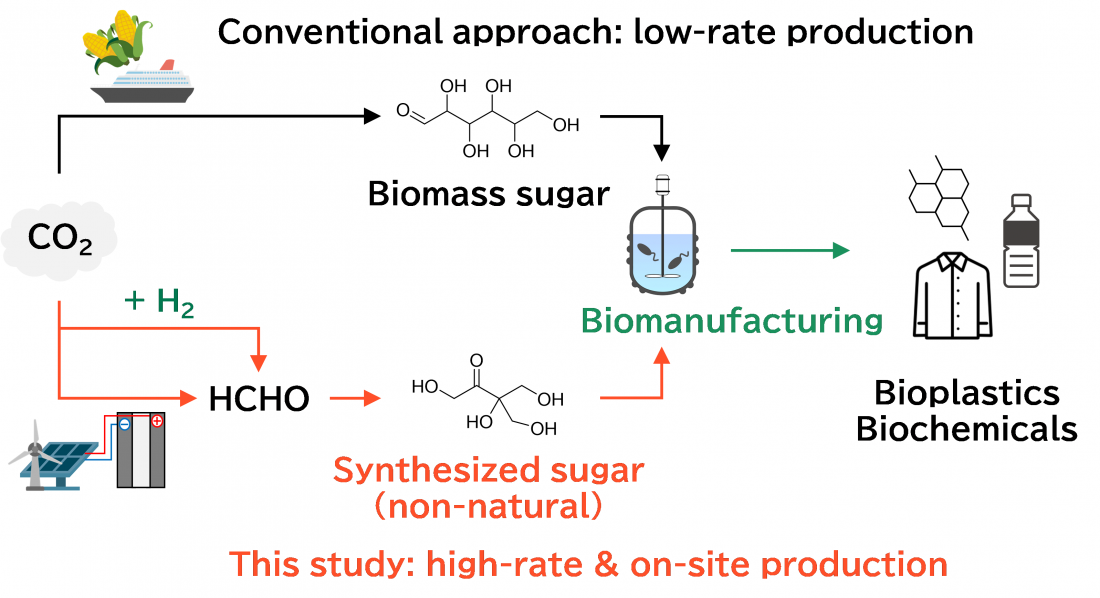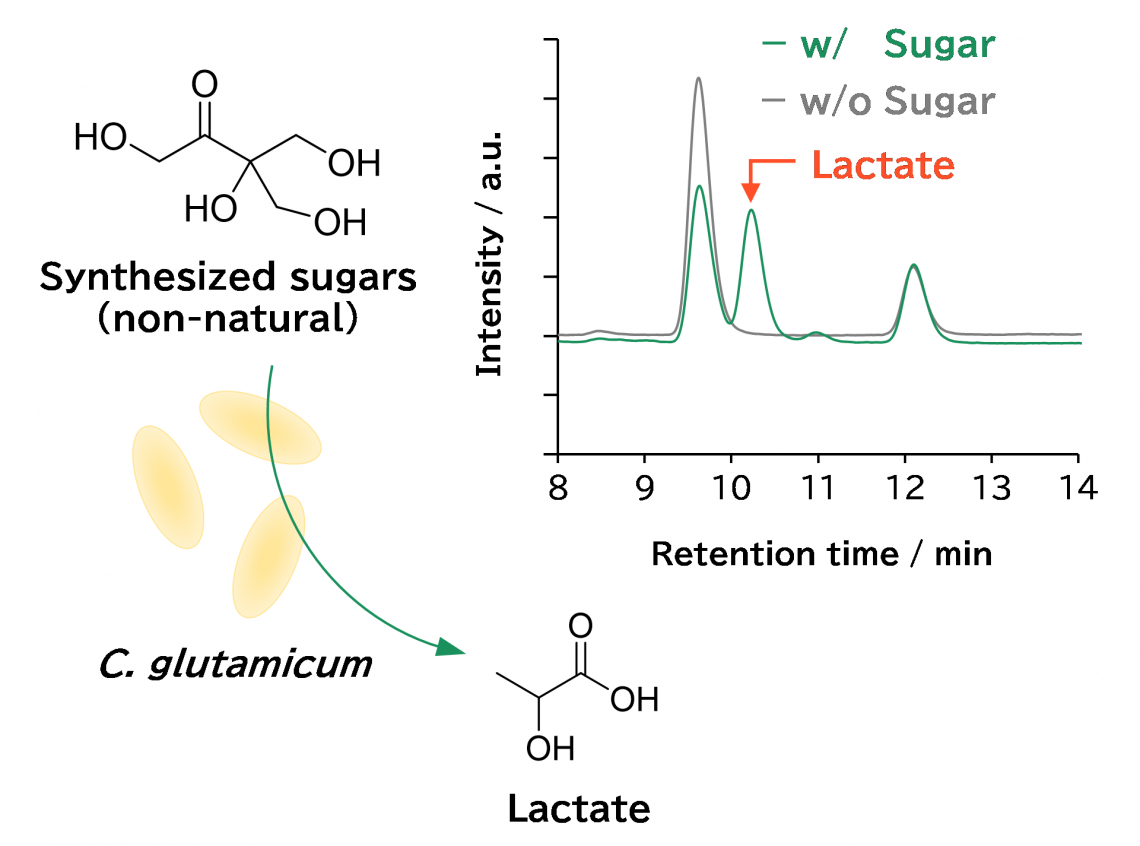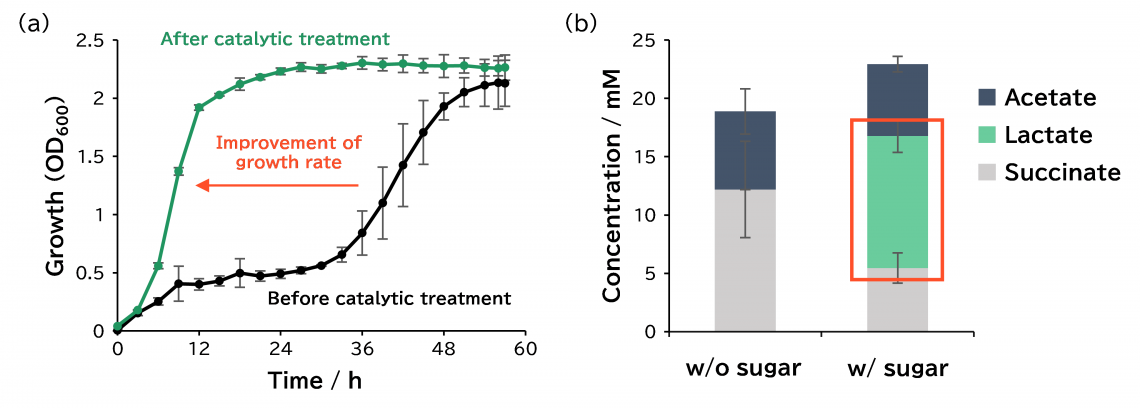Schematic illustration of the research concept (comparison with conventional approach).
Researchers from Osaka University and collaborating partners succeeded in biomanufacturing using chemically synthesized sugar for the first time in the world
Osaka, Japan – Biomanufacturing using biomass sugars such as corn obtained from agriculture is attracting attention as an environmentally friendly technology. However, the supply of such conventional biomass sugars is limited in relation to the huge demand for the production of fuels and chemical products, leading to concerns about competition with food due to the expansion of industrial use.
Now, in a study recently published in ChemBioChem, researchers from Osaka University and collaborating partners developed an innovative biomanufacturing technology using chemically synthesized non-natural sugars as a raw material to solve the above-mentioned problem (Fig. 1). Using bacteria (Corynebacterium glutamicum, C. glutamicum), they succeeded in fermentation production of lactate using synthesized sugar solutions as the sole substrate (Fig. 2). This is the first case in the world in which biomanufacturing was conducted using synthesized sugar as a raw material. This achievement will enable the procurement of sustainable raw sugar that does not compete with food and is expected to further expand biomanufacturing.
Since the Industrial Revolution, climate change caused by the excessive use of fossil fuels and the resulting greenhouse gas (GHG) emissions is a global challenge of the 21st century. Biomanufacturing is seen as one effective means of solving these issues, and its implementation is being actively promoted. The production of the main raw material (1st generation biomass) in current biomanufacturing relies on agricultural processes such as corn cultivation. However, there is concern that the supply of 1st generation biomass may compete with food, as it cannot satisfy the enormous demand for the production of fuels and chemical products. Furthermore, the production of sugar through large-scale agriculture has negative aspects such as land use, massive consumption of depletable resources such as fresh water, nitrogen, and phosphorus, water pollution due to eutrophication, and loss of biodiversity.
Lactate fermentation using chemically synthesized sugars as the substrate
The research group has been conducting research on chemically synthesized sugar that does not depend on agriculture and the application of the obtained sugar to bioprocesses. Chemical sugar synthesis has many advantages such as (1) an extremely high rate of synthesis (at least several hundred times faster than agricultural processes), (2) less use of water (about 1/1300 of agricultural processes), (3) less use of land (about 1/600 of agricultural processes), and (4) no need for nutrients such as phosphorus and nitrogen. However, chemically synthesized sugars are mixtures that contain many compounds with structures that do not exist in nature. Therefore, there have been challenges in using synthesized non-natural sugar solutions for bioprocesses, such as the presence of factors that inhibit the growth of bacteria.
In this study, the research group established a stable cultivation method using chemically synthesized sugar as a substrate, using C. glutamicum as a model bacterium. They also identified growth inhibitory factors in the synthesized sugar solution and showed that they can be removed by secondary catalytic treatment (Fig. 3a). Furthermore, by conducting fermentation under oxygen-limited conditions, they succeeded in the fermentation production of lactate using a synthesized sugar solution as the sole substrate despite their absence in nature (Fig. 3b). This is the first case in the world where bioproduction was conducted using agriculturally-independent synthesized sugar as a substrate. Lactate is produced via pyruvate, which is located at the end of a metabolic pathway called glycolysis. This means that this method can be widely and generally applied to biomanufacturing via glycolysis.
The results of this research have demonstrated that chemically synthesized sugar can be used as a new raw material for biomanufacturing. The use of chemically synthesized sugar, which can be produced at high rate and on-site, is expected to solve the problems of raw material supply in biomanufacturing, such as competition with food, regional dependence, and large-scale use of depletable resources, and is expected to be a game changer in this area.
(a) Growth curves of bacteria using chemically synthesized sugars as the substrate. Additional catalytic treatment removed growth inhibitors and improved growth rate. (b) Quantification results of organic acid fermentation using synthesized sugars as the substrate. The production of lactate was observed only when synthesized sugars were added.
###
The article, “Microbial Biomanufacturing Using Chemically Synthesized Non-Natural Sugars as the Substrate,” was published in ChemBioChem at DOI: https://doi.org/10.1002/cbic.202300760
About Osaka University
Osaka University was founded in 1931 as one of the seven imperial universities of Japan and is now one of Japan's leading comprehensive universities with a broad disciplinary spectrum. This strength is coupled with a singular drive for innovation that extends throughout the scientific process, from fundamental research to the creation of applied technology with positive economic impacts. Its commitment to innovation has been recognized in Japan and around the world, being named Japan's most innovative university in 2015 (Reuters 2015 Top 100) and one of the most innovative institutions in the world in 2017 (Innovative Universities and the Nature Index Innovation 2017). Now, Osaka University is leveraging its role as a Designated National University Corporation selected by the Ministry of Education, Culture, Sports, Science and Technology to contribute to innovation for human welfare, sustainable development of society, and social transformation.
Website: https://resou.osaka-u.ac.jp/en





